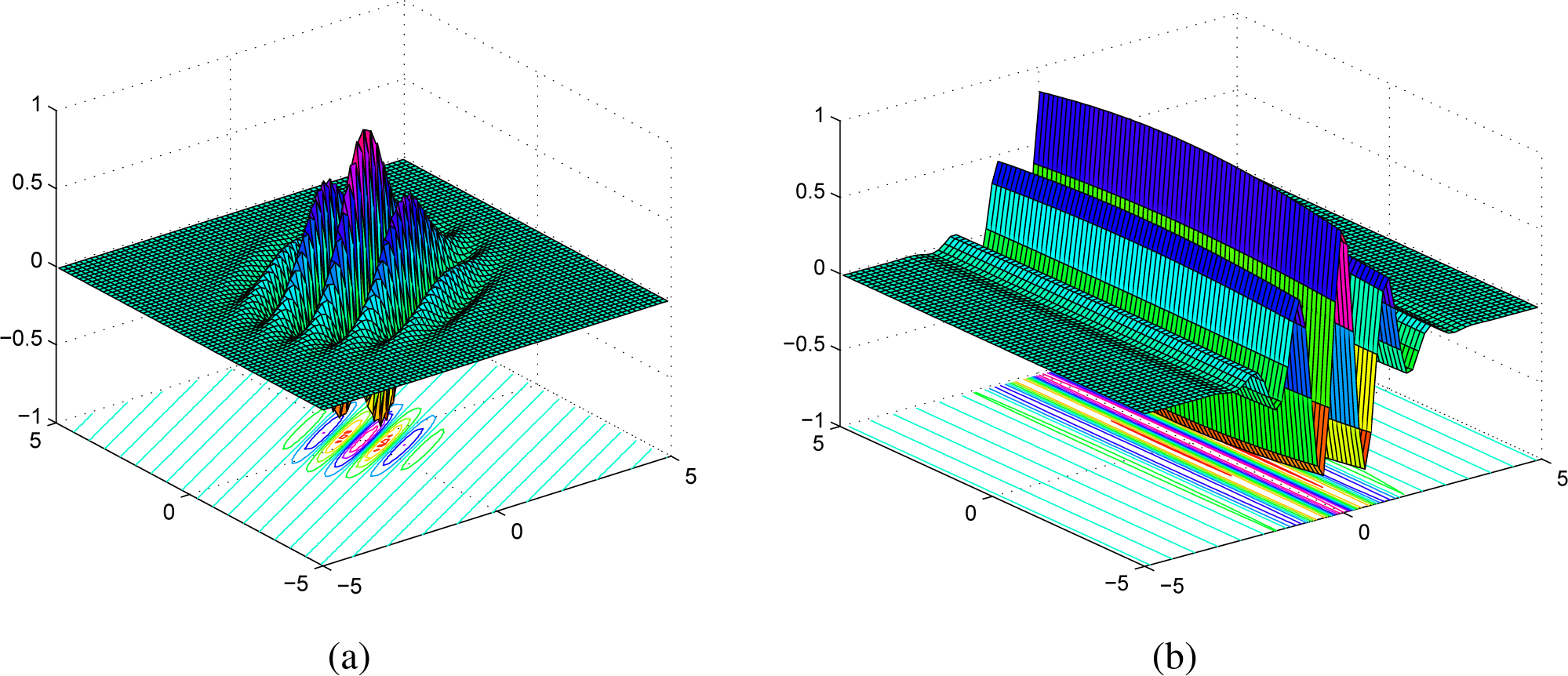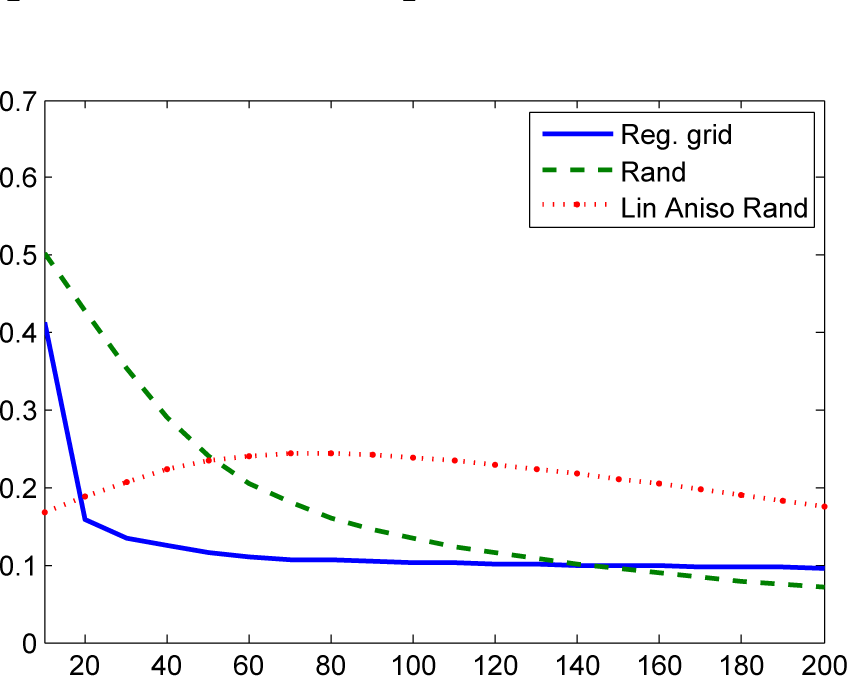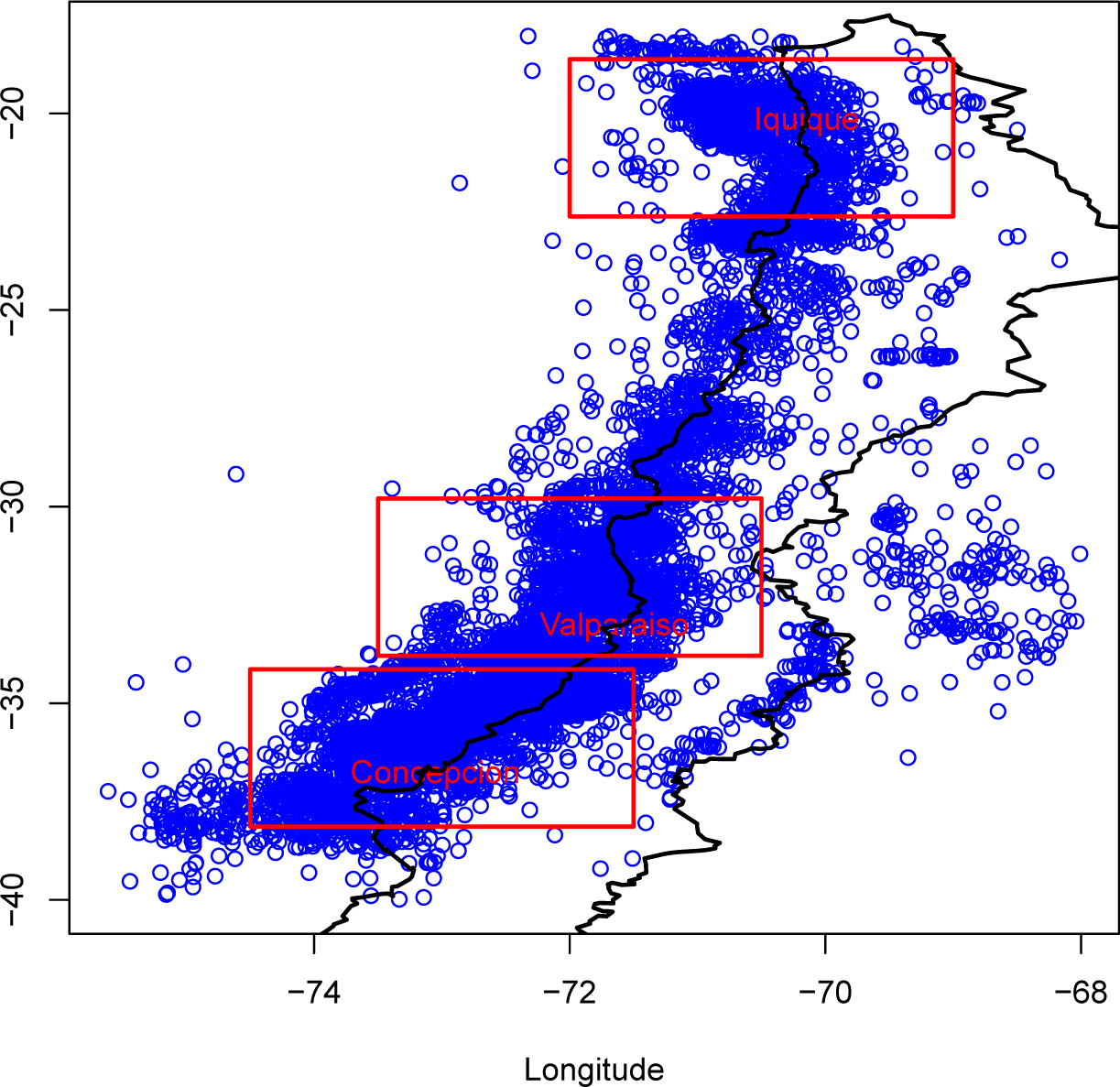2D Anisotropic Wavelet Entropy with an Application to Earthquakes in Chile
Abstract
:1. Introduction
2. Basics on Wavelets
3. Wavelet Entropy
4. Directional Wavelet Entropy
5. Simulation Study
6. Application to Earthquake Data
7. Conclusions
Acknowledgments
Author Contributions
Conflicts of Interest
References
- Clausius, R. On the Motive Power of Heat, and on the Laws which may be Deduced from it for the Theory of Heat. Ann. Phys. 1850, 20, 2010. [Google Scholar]
- Boltzmann, L. Einige Allgemeine Satze Iiber Warmegleichgewicht unter Gas-molekulen. Sitzungsber. Akad. Wiss. Wien 1871, 63, 679–711. [Google Scholar]
- Shannon, C. A Mathematical Theory of Communication. Bell Syst. Tech. J 1948, 27, 379–423. [Google Scholar]
- Sengupta, B.; Stemmler, M.B.; Friston, K.J. Information and Efficiency in the Nervous System-A Synthesis. PLoS Comput. Biol 2013, 9. [Google Scholar] [CrossRef]
- Wong, A.K.C.; Sahoo, P.K. A Gray Level Threshold Selection Method Based on Maximum Entropy Principle. IEEE Trans. Syst. Man. Cybern 1989, 19, 866–871. [Google Scholar]
- Zhang, Y.; Wu, L. Optimal Multi-Level Thresholding Based on Maximum Tsallis Entropy via an Artificial Bee Colony Approach. Entropy 2011, 13, 841–859. [Google Scholar]
- Oladipo, E.O. Spectral Analysis of Climatological Time Series: On the Performance of Periodogram, Non-integer and Maximum Entropy Methods. Theor. Appl. Climatol 1988, 39, 40–53. [Google Scholar]
- Koutsoyiannis, D. Uncertainty Entropy Scaling and Hydrological Stochastics, 2, Time Dependence of Hydrological Processes and time Scaling. Hydrol. Sci. J 2005, 50, 405–426. [Google Scholar]
- Li, S.; Zhou, Q.; Wu, S.; Dai, E. Measurement of Climate Complexity Using Sample Entropy. Int. J. Climatol 2006, 26, 2131–2139. [Google Scholar]
- AghaKouchak, A. Entropy-Copula in Hydrology and Climatology. J. Hydrometeorol 2014, 15, 2176–2189. [Google Scholar]
- Nicholson, T.; Sambridge, M.; Gudmundsson, O. On Entropy and Clustering in Earthquake Hypocentre Distributions. Geophys. J. Int 2000, 142, 37–51. [Google Scholar]
- Telesca, L.; Lapenna, V.; Lovallo, M. Information Entropy Analysis of Seismicity of Umbria-Marche Region (Central Italy). Nat. Hazards Earth Syst. Sci 2004, 4, 691–695. [Google Scholar]
- Telesca, L.; Lovallo, M.; Mohamed, A.E.E.A.; ElGabry, M.; El-hady, S.; Abou Elenean, K.M.; ElBary, R.E.F. Informational Analysis of Seismic Sequences by Applying the Fisher Information Measure and the Shannon Entropy: An Application to the 2004–2010 Seismicity of Aswan Area (Egypt). Physica A 2012, 391, 2889–2897. [Google Scholar]
- Telesca, L.; Lovallo, M.; Babayev, G.; Kadirov, F. Spectral and Informational Analysis of Seismicity: An Application to the 1996–2012 Seismicity of the Northern Caucasus-Azerbaijan Part of the Greater Caucasus-Kopet Dag Region. Physica A 2013, 392, 6064–6078. [Google Scholar]
- Telesca, L.; Lovallo, M.; Chamoli, A.; Dimri, V.P.; Srivastava, K. Fisher-Shannon Analysis of Seismograms of Tsunamigenic and Non-tsunamigenic Earthquakes. Physica A 2013, 392, 3424–3429. [Google Scholar]
- Telesca, L.; Lovallo, M.; Martí Molist, J.; Lopez Moreno, C.; Abella Mendelez, R. Using the Fisher-Shannon Method to Characterize Continuous Seismic Signal during Volcanic Eruptions: Application to 2011–2012 El Hierro (Canary Islands) Eruption. Terra Nova 2014, 26, 425–429. [Google Scholar]
- Rényi, A. On Measures of Entropy and Information, Proceedings of the 4th Berkeley Symposium on Mathematics, Statistics and Probability, Berkeley, CA, USA, 20 June–30 July 1960; Neyman, Jerzy, Ed.; Berkeley: New York, NY, USA, 1961; pp. 547–561.
- Papoulis, A. Probability, Random Variables and Stochastic Processes; McGraw-Hill: New York, NY, USA, 1984. [Google Scholar]
- Telesca, L.; Cuomo, V.; Lapenna, V.; Macchiato, M. Statistical Analysis of Fractal Properties of Point Processes Modelling Seismic Sequences. Phys. Earth Planet. Int 2001, 12, 65–83. [Google Scholar]
- Labat, D. Recent Advances in Wavelet Analyses: Part 1. A review of Concepts. J. Hydrol 2005, 314, 275–288. [Google Scholar]
- Rosso, O.; Blanco, S.; Yordanowa, J.; Kolev, V.; Figliola, A.; Schürmann, M.; Ba¸sar, E. Wavelet Entropy: A New Tool for Analysis of Short Duration Brain Electrical Signals. J. Neurosci. Methods 2001, 105, 65–75. [Google Scholar]
- Sello, S. Wavelet Entropy and the Multi-peaked Structure of Solar Cycle Maximum. New Astron 2003, 8, 105–117. [Google Scholar]
- Perez, D.G.; Zunino, L.; Garavaglia, M.; Rosso, O.A. Wavelet Entropy and Fractional Brownian Motion Time Series. Physica A 2006, 365, 282–288. [Google Scholar]
- Zunino, L.; Perez, D.G.; Garavaglia, M.; Rosso, O.A. Wavelet Entropy of Stochastic Processes. Physica A 2007, 379, 503–512. [Google Scholar]
- Lyubushin, A. Prognostic Properties of Low-Frequency Seismic Noise. Nat. Sci 2012, 4, 659–666. [Google Scholar]
- Lyubushin, A. How Soon would the next Mega-Earthquake Occur in Japan? Nat. Sci 2013, 5, 1–7. [Google Scholar]
- Donoho, D.L. Nonlinear Wavelet Methods for Recovery of Signals Densities Spectra from Indirect and Noisy Data. In Proceedings of Symposia in Applied Mathematics; American Mathematical Society; Washington, WA, USA, 1993; pp. 173–205. [Google Scholar]
- Gao, W.; Li, B.L. Wavelet Analysis of Coherent Structures at the Atmosphere-Forest Interface. J. Appl. Meteorol 1993, 32, 1717–1725. [Google Scholar]
- Grenfell, N.; Bjørnstad, B.T.O.; Kappey, J. Travelling Waves and Spatial Hierarchies in Measles Epidemics. Nature 2001, 414, 716–723. [Google Scholar]
- Saunders, S.C.; Chen, J.; Crow, T.R.; Brofoske, K.D. Hierarchical Relationships between Landscape Structure and Temperature in a Managed Forest Landscape. Landsc. Ecol 1998, 13, 381–395. [Google Scholar]
- Brosofske, K.D.; Chen, J.; Crow, T.R.; Saunders, S.C. Vegetation Responses to Landscape Structure at Multiple Scales across a Northern Wisconsin, USA, Pine Barrens Landscape. Plant Ecol 1999, 143, 203–318. [Google Scholar]
- Harper, K.A.; Macdonald, S.E. Structure and Composition of Riparian Boreal Forest: New Methods for Analyzing Edge Influence. Ecology 2001, 82, 649–659. [Google Scholar]
- Perry, J.N.; Liebhold, A.M.; Rosenberg, M.S.; Dungan, J.; Miriti, M.; Jakomulska, A.; Citron-Pousty, S. Illustrations and Guidelines for Selecting Statistical Methods for Quantifying Spatial Pattern in Ecological Data. Ecography 2002, 25, 578–600. [Google Scholar]
- Mateu, J.; Nicolis, O. Multiresolution Analysis of Linearly-Oriented Spatial Point Patterns. J. Stat. Comput. Simul 2015, 8, 621–637. [Google Scholar]
- Goodall, D.W. Some Considerations in the Use of Point Quadrats for the Analysis of Vegetation. Aust. J. Sci. Res. B 1952, 5, 1–41. [Google Scholar]
- Matérn, B. Spatial Variation: Stochastic Models and their Application to some Problems in Forest Surveys and other Sampling Investigations. Esselte 1960, 49, 5. [Google Scholar]
- Matérn, B. Spatial Variation, 2nd ed; Springer: Berlin, Germany, 1986. [Google Scholar]
- Ripley, B.D. Spatial Statistics; Wiley: New York, NY, USA, 1981. [Google Scholar]
- Neyman, J.; Scott, E.L. Statisical Approach to Problems of Cosmology. J. R. Stat. Soc. B 1958, 20, 1–43. [Google Scholar]
- Cliff, A.D.; Ord, J.K. Spatial Processes: Models and Applications; Pion: London, UK, 1981. [Google Scholar]
- Ogata, Y. Space-Time Point Process Models for Earthquake Occurrences. Ann. Inst. Stat. Math 1998, 50, 379–402. [Google Scholar]
- Diggle, P.J.; Richardson, S. Epidemiological Studies of Industrial Pollutants: An Introduction. Int. Stat. Rev 1993, 61, 203–206. [Google Scholar]
- Stoyan, D.; Kendall, W.; Mecke, J. Stochastic Geometry and its Applications, 2nd ed; Wiley: Chichester, UK, 1995. [Google Scholar]
- Diggle, P.J. Statistical Analysis of Spatial Point Patterns; Hodder Education: London, UK, 2003. [Google Scholar]
- Baddeley, A.; Gregori, P.; Mateu, J.; Stoica, R.; Stoyan, D. (Eds.) Case Studies in Spatial Point Process Modeling (Lecture Notes in Statistics); Springer: Berlin, Germany, 2006.
- Illian, J.; Penttinen, A.; Stoyan, H.; Stoyan, D. Statistical Analysis and Modeling of Spatial Point Patterns; Wiley: Chichester, UK, 2008. [Google Scholar]
- Gelfand, A.E.; Diggle, P.J.; Fuentes, M.; Guttorp, P. (Eds.) Handbook of Spatial Statistics; CRC Press: Boca Raton, FL, USA, 2010.
- Ohser, J.; Stoyan, D. On the Second-Order and Orientation Analysis of Planar Stationary Point Processes. Biometr. J 1981, 23, 523–533. [Google Scholar]
- Stoyan, D.; Benes, V. Anisotropy Analysis for Particle Systems. J. Microsc 1991, 164, 159–168. [Google Scholar]
- Mateu, J. Second-Order Characteristics of Spatial Marked Processes with Applications. Nonlinear Anal. R. World Appl 2000, 1, 145–162. [Google Scholar]
- Redenbach, C.; Särkkä, A.; Freitag, J.; Schladitz, K. Anisotropy Analysis of Pressed Point Processes. Adv. Stat. Anal 2009, 93, 237–261. [Google Scholar]
- Møller, J.; Rasmussen, J.G. A Sequential Point Process Model and Bayesian Inference for Spatial Point Patterns with Linear Structures. Scand. J. Stat 2012, 39, 618–634. [Google Scholar]
- Telesca, L.; Lovallo, M.; Golay, J.; Kanevski, M. Comparing Seismicity Declustering Techniques by Means of the Joint Use of Allan Factor and Morisita Index. Stoch. Environ. Res. Risk Assess 2015. [Google Scholar] [CrossRef]
- Schenk, H.J.; Mahall, B.E. Positive and Negative Interactions Contribute to a North-South-Patterned Association between two Desert Shrub Species. Oecologia 2002, 132, 402–410. [Google Scholar]
- Rosenberg, M.S. Wavelet Analysis for Detecting Anisotropy in Point Patterns. J. Veg. Sci 2004, 15, 277–284. [Google Scholar]
- Blanco, S.; Figliola, A.; Quiroga, R.Q.; Rosso, O.A.; Serrano, E. Time-Frequency Analysis of Electroencephalogram Series. III. Wavelet Packets and Information Cost Function. Phys. Rev. E 1998, 57, 932–940. [Google Scholar]
- Vidakovic, B. Statistical Modeling by Wavelets; Wiley: New York, NY, USA, 1999. [Google Scholar]
- Mallat, S. A Wavelet Tour of Signal Processing; Academic Press: Waltham, MA, USA, 1999. [Google Scholar]
- Neupauer, R.M.; Powell, K.L. A Fully-Anisotropic Morlet Wavelet to Identify Dominant Orientations in a Porous Medium. Comput. Geosci 2005, 31, 465–471. [Google Scholar]
- Kumar, P. A Wavelet Based Methodology for Scale-Space Anisotropic Analysis. Geophys. Res. Lett 1995, 22, 2777–2780. [Google Scholar]
- Brillinger, D. Some Wavelet Analyses of Point Process Data, Proceedings of the Thirty-First Asilomar Conference on Signals, Systems and Computers; IEEE, 1–4 November 1998; Universidade de Sao Paulo: Brazil; pp. 1087–1091.
- Nicolis, O. Spatio-Temporal Analysis of Earthquake Occurrences Using a Multiresolution Approach, Mathematics of Planet Earth Lecture Notes in Earth System Sciences; Springer: Berlin, Heidelberg, Germany, 2014; pp. 179–183.











| Wavelet Entropy | |
|---|---|
| Regular | 2.47 |
| Random | 3.60 |
| Random + linear | 4.30 |
| Wavelet Entropy | |
|---|---|
| Window 1 | 4.30 |
| Window 2 | 4.55 |
| Window 3 | 4.30 |
| Window 1 (before) | 4.31 |
| Window 1 (after) | 4.29 |
© 2015 by the authors; licensee MDPI, Basel, Switzerland This article is an open access article distributed under the terms and conditions of the Creative Commons Attribution license (http://creativecommons.org/licenses/by/4.0/).
Share and Cite
Nicolis, O.; Mateu, J. 2D Anisotropic Wavelet Entropy with an Application to Earthquakes in Chile. Entropy 2015, 17, 4155-4172. https://doi.org/10.3390/e17064155
Nicolis O, Mateu J. 2D Anisotropic Wavelet Entropy with an Application to Earthquakes in Chile. Entropy. 2015; 17(6):4155-4172. https://doi.org/10.3390/e17064155
Chicago/Turabian StyleNicolis, Orietta, and Jorge Mateu. 2015. "2D Anisotropic Wavelet Entropy with an Application to Earthquakes in Chile" Entropy 17, no. 6: 4155-4172. https://doi.org/10.3390/e17064155





